Most of the best fly fishermen I know started off on traditional tackle, and many still look to their old gear for inspiration when putting together a solution to a fishy problem.
Flies tied to look and act like lures, custom rigs, and purpose-built leaders are commonplace in a fly fishing culture that is steadily moving away from its tweed-clad roots. One of my favorite nuggets of wisdom adapted from outside of the fly fishing world is the drop shot rig.
Bass fisherman have been successfully jigging soft plastics on drop shot rigs for decades. Rigged for the fly rod, drop shotting works great for targeting trout and salmon in water that is too deep and fast for even the heaviest nymphs.
A drop shot rig simply suspends your fly in the water column above a weight. This rig allows you to get deep quickly and fine-tune the depth of your fly until you start getting hits. Similar to various contact nymphing methods, feeling the weight bounce and drag on the bottom provides a constant point of reference and greatly increases strike detection.
Here are a few drop shot builds and how to fish them.
THE RIGS
More Like This
Traditional Dropper Rig
- Line up a 8-12 inch length of tippet material parallel to the end of your leader and tie them together using a triple surgeon’s knot at the top of the two pieces.
- Cut off the top tag-end and shorten the fly-dropper by a few inches.
- Tie a stop-knot to the bottom of the leader with several overhand knots.
- Tie your fly to the dropper, and pinch your split shot above the stop-knot.

You can set the depth of your fly by the distance between your drop shot and fly dropper, but make sure the length of your fly-dropper is shorter than your drop shot, or expect to get tangled. The fly should flow along at the determined depth as the rig is dragged along by the current.If you want to change the depth of the rig, you’ll have to either retie it with a longer or shorter drop shot section, or use an adjustable dropper.
Adjustable Dropper Rig
Adjustable droppers are awesome for quickly changing fly depth, but make sure you tie a beefy stop knot — it's the only thing keeping the dropper from sliding off.
- Tie a stop-knot at the end of your leader.
- Tie a triple-surgeon’s or perfection loop at one end of your fly-dropper.
- Lay the leader over top of your dropper perpendicularly, and pull the fly-end of the dropper through the loop around the leader.
- Loosen and slide the dropper-loop up or down to adjust.

K.I.S.S Dropper Rig
When you’re having one of those days where you seem to get stuck after every other drift, keep it simple to minimize downtime between frequent re-riggings.
- Use an unweighted nymph tied to your tippet with an improved clinch knot (or your preference).
- Leave the tag-end of the knot a few inches longer than the distance you want your fly above the bottom.
- Make a stop-knot at the end of the tag-end.
- Pinch split shot above the stop-knot.

I’ve fished this build pretty extensively on spring run landlocks and rainbows with nymphs and egg patterns when high, fast water means there’s plenty of debris to lose flies on. It only takes about 20 seconds longer to put this build together than to tie on a new fly.
ADJUSTABLE WEIGHT
Getting the fly down to the fish is the most important piece of the puzzle. You’ll need to adjust how much weight you use based on the water type, depth, current, etc.
Too little, and the drift is over before you even hit bottom. Too much, and you’re more likely to get tangled, not feel a strike, or cause personal injury.
in addition to just stacking split shot, you can tie a barrel swivel and snap to the end of the leader where your stop-knot would be, and simply clip on different size slinky weights or swivel-sinkers based on the water conditions.
LEADER
Leaders for drop shot rigs couldn’t be more simple. Use a standard tapered leader if you want, or even a straight section of mono will suffice. You won’t have to worry about delicate presentations, and the deep, dirty water you’re likely to use this rig in, means fish won't be too leader shy.
In general, your overall leader should be about 1 ½ times as long as the water is deep — and longer if the water is really moving. A good length of multicolored monofilament used as an inline indicator can help detect strikes and keep track of water depth. Using a tippet ring below your indicator mono allows you to quickly change setups or recover from snags without having to build an entirely new leader.
METHOD
You don’t have to worry about being savaged by a pack of purists the next time you decide to try fishing a drop shot rig — nothing’s hatching when this bad boy is called for.
While you can certainly fish this versatile rig throughout the year, it will be most effective over other methods in deep, fast water following winter run-off and heavy rains.
This rig will work for everything from tiny midge patterns to small streamers. On migratory fish, use egg patterns in the spring or fall to make the most of deep pools where fish are stacked up. For multi-fly rigs you can simply tie on an additional dropper higher up the tippet with a surgeon’s knot, or add a sliding dropper using the method described above.
While they can be used with an indicator, drop shot rigs are meant to be fished tight line style — with your rod held high and parallel to the water as you follow the drift. Very little of the actual fly line should be out of the rod guides. Simply drop or cast the rig where you want it, give a little slack to let it sink, watch and feel for an indication that the fly has hit bottom, and lift your rod tip until your leader is almost taught and you can feel the weights bouncing. Now just follow the current until the end of your drift, and toss your rig upstream into the next section to repeat. You can detect strikes when your leader suddenly stops short, straightens out, twitches, or you simply feel the hit. Strikes can be subtle, so don’t be afraid to set the hook often and at the end of every drift. Like many other tight line methods, this is a pretty low impact rig, so don’t worry too much about spooking fish unless you happen to club them with it (oops).
CATCH
There is a time and place for a more delicate and elegant approach to fly fishing, but sometimes catching fish is more important than looking pretty.
To paraphrase the great Kelly Galloup: the ideal nymph fisherman will hit bottom as quickly as possible with as little weight as possible. A drop shot rig allows a fly fisherman to accomplish this with the maximum tactile awareness, and opens up previously unfishable holes usually commanded by snaggers and poorly behaved weekend warriors dredging egg sacks. Drop shot rigs might not look dignified, but they just work. Fly anglers should take a page out of the gear-guys’ playbook and try one for themselves this season.




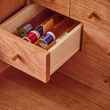


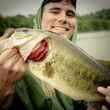






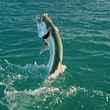




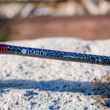
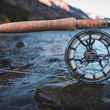



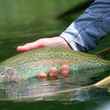




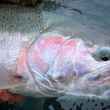

Comments
Alex Argyros replied on Permalink
Thanks for the interesting and useful article.
Could you tell me your thoughts on using a drop shot rig vs. a more traditional Euro setup in average freestone conditions (say water that is moving but not ripping and is 2-4 ft. deep)?
Larry Tullis replied on Permalink
I'm old so have a comment about the history of the rig. Many people know this rig (bottom weighted, with 1 or 2 droppers above) as the "Provo River Bounce Rig". "Drop-shotting" is a more modern term borrowed from bass anglers. I talked to older timers that used it back in the 1930's with bamboo fly rods, silk lines and cat gut leader. It was a popular rig to use on the Provo River with spinning tackle too in the 70's and 80's (no indicator). It evolved back to fly gear when strike indicators became popular in the 80's. Most of the guides on the Provo River, like myself, still use the bounce rig with long, light rods such as those developed for "high stick" or "Euro" nymphing and I often use it combined with long tenkara rods, 11 to 18 feet long as well. The key to the bounce rig is the weights track the bottom and keep the flies in the deeper strike zone for a much longer time than standard nymphing rigs and also slows the flies down to a more accurate speed with the bottom currents. If the indicator (or sighter) is "bouncing" or going slower than the surface, you are in the zone to catch more fish. Euro Nymphing (high-stick nymphing) is very similar except you watch the sighter instead of the indicator, and you have weighted flies instead of split shot on the bottom, which is how I started nymphing in the mid 70's (high-stick nymphing). High-stick/Euro nymphing is deadly for close-in fishing in fast water and bounce nymphing gives you more distance options, especially on larger streams with long runs.
John replied on Permalink
Dropshot rigs are illegal in Michigan due to use by snaggers.
Pages